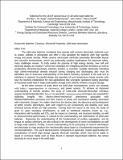Editorial for the JECR special issue on all solid-state batteries
Author(s)
Rettenwander, Daniel; Kilner, John; Doeff, Marca; Rupp, Jennifer L. M.; Rupp, Jennifer Lilia Marguerite
Download10832_2017_102_ReferencePDF.pdf (190.1Kb)
OPEN_ACCESS_POLICY
Open Access Policy
Creative Commons Attribution-Noncommercial-Share Alike
Terms of use
Metadata
Show full item recordAbstract
The solid-state batteries considered here operate with ceramic electrolyte materials such as oxides, sulfides or phosphates and offer a new paradigm for batteries with high specific energy and power density. While ceramic electrolytes eliminate potentially flammable liquids and corrosive environments, which has profoundly positive implications for improved safety, many challenges remain. To fully realize the promise of high energy density, new cell and electrode designs are needed. Furthermore, strategies for mitigating dendrite formation as well as accelerating electrode-electrolyte interface kinetics is essential. Suitable electrodes tolerating high chemo-mechanical stresses induced during charging and discharging also must be identified, and an improved understanding of the defect chemistry operative in the bulk and at interfaces is required. Successful design and operation of such temperature-robust ceramic cells have far-reaching implications for new applications like synergetic operations taking advantage of industrial waste heat in large-scale battery storage units, electric vehicles, and grid storage.
Date issued
2017-08Department
Massachusetts Institute of Technology. Department of Materials Science and EngineeringJournal
Journal of Electroceramics
Publisher
Springer-Verlag
Citation
Rupp, Jennifer L. M. et al. “Editorial for the JECR Special Issue on All Solid-State Batteries.” Journal of Electroceramics 38, 2–4 (June 2017): 125–127 © 2017 Springer Science+Business Media, LLC
Version: Author's final manuscript
ISSN
1385-3449
1573-8663